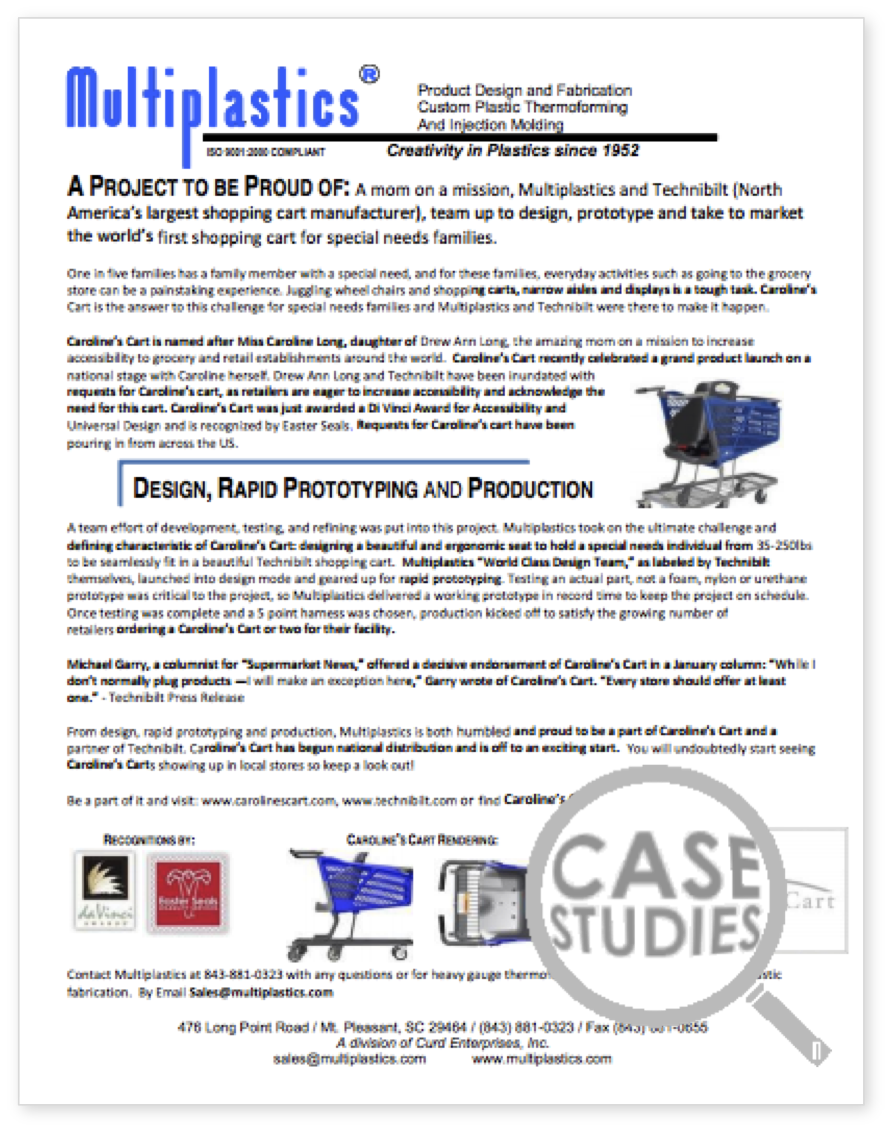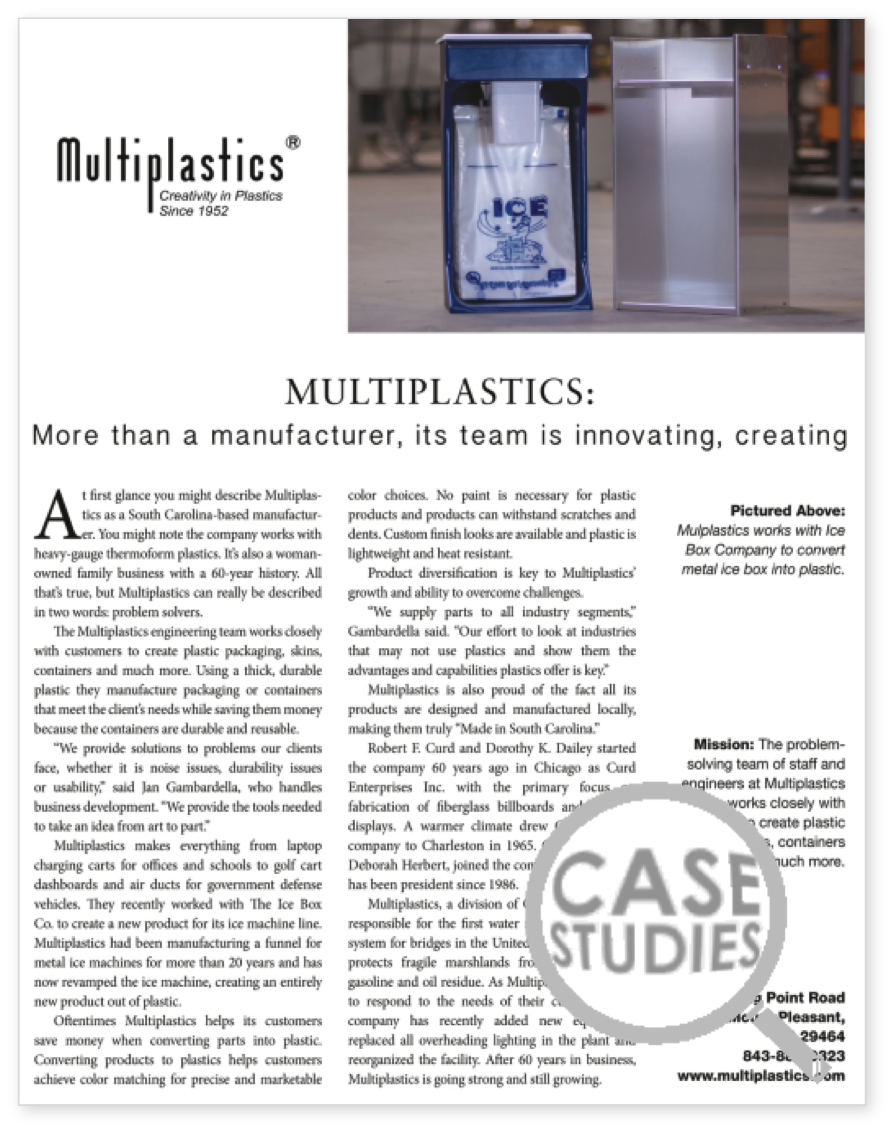Our Company
EXPERIENCE in Plastics Since 1952
Robert F. Curd founded Curd Enterprises in 1952 in the Chicago area. The primary business was fabrication of fiberglass billboard displays and product displays such as the Sinclair Oil Company dinosaurs, RCA Nipper (including the one that currently resides on the old RCA building in Albany, NY) and Turtle Wax Turtles.
Multiplastics is a trademark of Curd Enterprises Inc. for the manufacture of fabricated plastic displays and plastic products. It was through this name that the company became known for innovative and creative manufacturing of thermoformed plastic products.
The company moved into thermoforming as an alternative to the hand layup of fiberglass for the billboard industry. Bob Curd designed and built the largest thermoformer in the United States to manufacture displays and billboard trim.
In 1965, the company moved its manufacturing operations from Addison, IL to Charleston, SC. Product diversity continued and in the early 70's, the company established a proprietary line of plastic buoys. These buoys are marketed worldwide and are used in both freshwater and ocean areas. The first metalizing of clear acrylic domes was devised by Bob Curd to provide a two-way mirror effect for the security industry.
Bob Curd's daughter Deborah Herbert joined the company in 1979 and became President in 1992. In 1986, the company moved from North Charleston to Mount Pleasant, SC.
It was here that the company designed and built the first water runoff containment system for bridges in the United States. The system was designed to protect fragile marshlands from the effects of gasoline and oil residue running off the bridge deck. The containment system installed near Mount Pleasant has over 2 miles of specially designed pans that collect the water with the oil/gas residue and contain it until it can be safely removed.
The company acquired another 85,000 square feet of manufacturing space for a total occupancy of 138,000 square feet. Achievement of ISO 9001 Certification in 1997 demonstrates the company's commitment to quality product.
The company continues to be an innovator in thermoforming and has added injection-molding capability for more versatility in meeting customers needs.
CREATIVITY in Plastics since 1952
Our culture of creativity has driven our success for over 60 years. The possibilities with plastics are endless with the array of textures, colors, and shapes achievable with our forming process. We see a canvas of opportunity in every sheet of plastic.
ENGINEERING SOLUTIONS in Plastics since 1952
Solving problems for companies large and small is in our DNA. Our R&D team, design team, and engineering team work in unison to develop scalable solutions for anything from equipment housings, covers, light boxes, hydroponics, grocery displays, to packaging, and beyond. Out of all the materials on our green earth, we chose plastic.
WHY PLASTIC?
Strength
Plastic parts can be designed to be weight bearing, structural, impact resistant and are naturally dent resistant.
Parts can be reinforced with ribbing (welded or bonded) for added strength.
Bends, folds and formed details increase part strength while adding aesthetic design components.
Plastics have tremendous impact resistance and will bend and flex to absorb impact when tested and often will not show dents or other permanent, post-impact markings.
Corrosion Resistance
Molded plastic products can be more weather resistant than metal or wood products.
Plastic can withstand a wide variety of temperature and humidity conditions and will not corrode. Additives may be included in the plastic to combat UV exposure for increased material service life.
Chemical Resistance
Many chemical compounds cannot penetrate plastic, so various plastics can handle many cleaning solutions and years of cleaning without failure.
The chemical resistance of engineering plastics makes them an ideal material for many applications.
Recyclable
All scrap, shavings, and cut offs are reground and recycled into new plastic for use in our plant. It makes sense and saves cents for our planet and our plant.
Aesthetics
Color is embedded in the material, so no painting is necessary. Most plastic parts have no finish to chip off so parts remain beautiful, even in demanding applications in harsh environments.
Textures for any application hide scratches, prolong the beauty of the part and offer unique surfaces difficult to achieve with other materials.
Economics
Parts formed from plastic weigh less than parts formed from other materials. This translates to lower part cost, less end-product weight and less shipping expense.
Plastic parts are often less expensive than identical parts made in metal.
Plastics require very little finishing and are called self-finishing materials, because they require no paint or polish.
This decreases time in manufacturing finished parts.
Machining Tight Tolerances.
Engineering plastics can be easily machined to tight tolerances with less machine force and less clamp force then metal.
Threading, milling, tapping sawing and drilling are easily accomplished with plastics.



